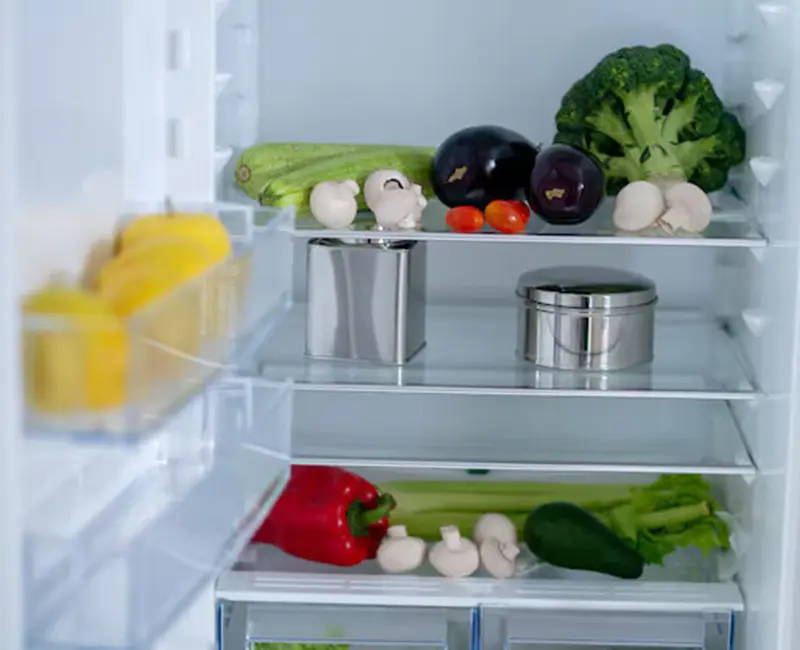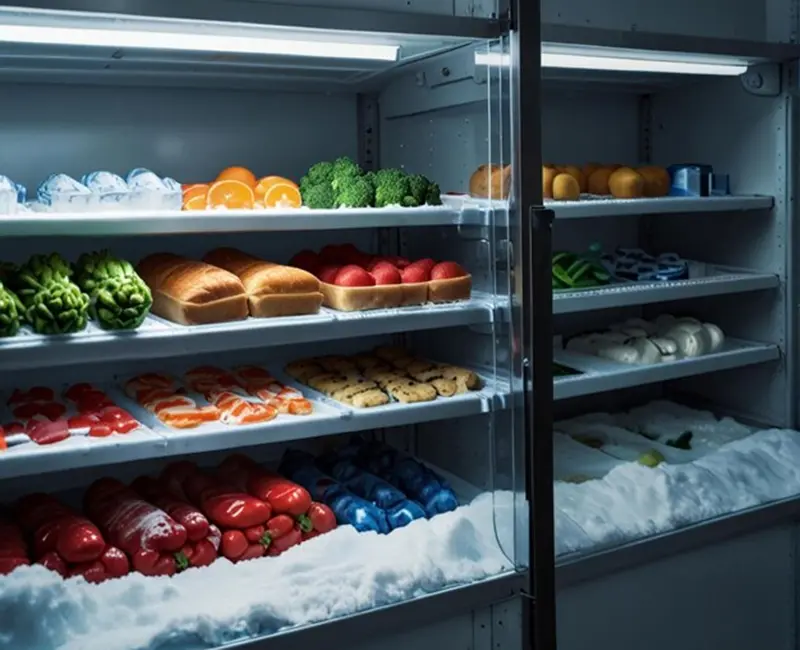Mini Fridge Heat Exchangers: Balancing Compact Design & High Efficiency

Mini fridge heat exchangers play a critical role in ensuring efficient heat transfer within compact appliances. They enable these small refrigerators to maintain optimal cooling performance without compromising on size. Achieving this balance requires advanced materials and innovative designs. For instance, copper fin heat exchangers have gained popularity due to their excellent thermal conductivity and energy efficiency.
Ningbo Senjun New Materials Co., Ltd. has emerged as a leader in this field. Their copper aluminum fin heat exchangers cater to a growing demand for high-performance solutions. Recent trends show a shift towards efficient and eco-friendly products, driven by global energy conservation goals. This demand is further fueled by emerging industries like new energy vehicles and data centers, which require cutting-edge heat exchange technologies.
Key Takeaways
- Mini fridge heat exchangers are important for keeping things cool. They save space and keep the right temperature.
- Copper aluminum fin heat exchangers work well because they are light. They also move heat quickly, making them great for mini fridges.
- Cleaning heat exchangers every three to six months is helpful. It keeps them working well and makes your fridge last longer.
- Using eco-friendly refrigerants like propane and CO2 is better. It helps the fridge work well and is good for the planet.
- Adding smart sensors to mini fridges is a smart idea. They check and adjust things to save energy and work better.
What Are Mini Fridge Heat Exchangers?
Definition and Function
What is a heat exchanger?
A heat exchanger is a device designed to transfer heat between two or more fluids without mixing them. It plays a pivotal role in refrigeration systems by facilitating the movement of heat from the interior of the fridge to the external environment. This process ensures that the desired cooling temperature is maintained efficiently.
Heat exchangers come in various forms, each tailored to specific applications. For mini fridges, compact designs like copper fin heat exchangers are often preferred due to their excellent thermal conductivity and space-saving properties.
How do heat exchangers work in mini fridges?
Mini fridge heat exchangers operate by leveraging either thermoelectric or vapor-compression technologies. These systems rely on the principles of heat absorption and dissipation to regulate internal temperatures. Here's a breakdown of common technologies:
| Technology Type | Key Features | Efficiency Considerations |
|---|---|---|
| Peltier Modules | Operate on the Peltier effect; compact size; silent operation; precise control | Generally lower efficiency compared to vapor-compression systems; limited cooling capacity |
| Vapor-Compression Cycles | High cooling efficiency; established technology; relies on refrigerants | Significant greenhouse gas emissions; optimization needed for sustainability |
| Hybrid Systems | Integrate Peltier and vapor-compression; potential for energy savings | Operational parameters like temperature gradients and refrigerant choice are crucial |
Each system has unique advantages. For instance, vapor-compression cycles are widely used due to their high cooling efficiency, while hybrid systems offer a balance between energy savings and performance.
Importance in Mini Fridges
Role in temperature regulation
The heat exchanger is the backbone of temperature regulation in mini fridges. It ensures that heat is efficiently removed from the fridge's interior, maintaining a stable and cool environment for stored items. Research highlights the importance of heat sink design in thermoelectric cooling systems, as it directly impacts cooling performance.
Contribution to energy efficiency
Energy efficiency is a critical factor in modern refrigeration. Optimized heat exchangers reduce energy consumption by enhancing heat transfer processes. Computational studies have shown that improving heat exchanger designs can significantly boost energy efficiency. This is why advanced materials like copper fin heat exchangers are increasingly used—they offer superior thermal conductivity, ensuring effective heat dissipation with minimal energy loss.
The Challenge of Compact Design

Space Constraints
Limited internal and external space
Compact designs in mini fridges often face spatial limitations that challenge engineers. I’ve observed that the internal layout can sometimes feel inefficient, with awkward shelving arrangements leading to wasted space. Additionally, these fridges are typically freestanding, which restricts installation options and limits placement flexibility. These spatial constraints demand innovative solutions to maximize cooling performance without compromising usability.
Impact on heat dissipation
Space limitations directly affect heat dissipation. Smaller designs reduce the surface area available for heat exchange, making it harder to achieve optimal cooling. Engineers address this by optimizing heat sink designs to lower thermal resistance and enhance dissipation. For example, increasing the surface area and refining fin designs significantly improve convective heat transfer. Experimental tests have validated these approaches, showing a strong correlation between optimized designs and better cooling efficiency.
| Aspect | Findings |
|---|---|
| Thermal Management | Optimized heat sink designs significantly reduce thermal resistance, enhancing heat dissipation. |
| Design Parameters | Increasing surface area and optimizing fin design improves convective heat transfer and cooling. |
| Numerical Simulations | Simulations assess performance under varying conditions, providing insights for design modifications. |
| Experimental Validation | Tests show a strong correlation between optimized designs and improved cooling efficiency. |
Design Trade-offs
Balancing size, weight, and performance
Mini fridge heat exchangers require a delicate balance between size, weight, and performance. I’ve seen how reducing the size often increases the complexity of maintaining cooling efficiency. Lightweight materials help minimize the overall weight, but they must also provide sufficient thermal conductivity to ensure effective heat transfer. This trade-off is a constant challenge for engineers striving to meet consumer demands for compact yet powerful appliances.
Challenges in material selection
Material selection plays a critical role in overcoming design trade-offs. Copper aluminum fin heat exchangers, like those developed by Ningbo Senjun New Materials Co., Ltd., offer a practical solution. Copper’s high thermal conductivity ensures efficient heat transfer, while aluminum’s lightweight properties make it ideal for compact designs. Engineers must carefully evaluate these materials to achieve the perfect balance between durability, efficiency, and cost-effectiveness.
Achieving High Efficiency in a Small Space

Advanced Technologies
Microchannel heat exchangers
Microchannel heat exchangers have revolutionized cooling systems in mini fridges. These devices use narrow channels to enhance heat transfer by increasing the surface area for fluid interaction. I’ve noticed that their compact design makes them ideal for small appliances, where space is limited. By reducing thermal resistance, microchannel heat exchangers achieve higher efficiency compared to traditional designs. Research also highlights their ability to handle higher pressures, which further improves performance in confined spaces.
Use of thermoelectric cooling systems
Thermoelectric cooling systems (TECs) offer unique advantages for mini fridges. They operate silently, have no moving parts, and provide precise temperature control. I’ve seen how optimizing the placement and dimensions of Peltier modules within these systems significantly enhances cooling efficiency. For instance, adjusting the thermal interface of these modules improves heat transfer, leading to better performance. Studies also show that integrating liquid-cooled blocks or nanofluids into TECs can further boost their efficiency, making them a promising choice for compact refrigeration.
Material Innovations
Copper fin heat exchangers for enhanced thermal conductivity
Copper fin heat exchangers are a cornerstone of high-efficiency mini fridges. Copper’s superior thermal conductivity ensures rapid heat transfer, which is crucial in compact designs. I’ve observed that these heat exchangers not only improve cooling performance but also reduce energy consumption. Ningbo Senjun New Materials Co., Ltd. has developed advanced copper aluminum fin heat exchangers that combine copper’s efficiency with aluminum’s lightweight properties. This innovation strikes the perfect balance between performance and practicality.
Corrosion-resistant coatings
Corrosion-resistant coatings extend the lifespan of heat exchangers by protecting them from environmental damage. These coatings prevent oxidation and degradation, ensuring consistent performance over time. I’ve found that applying such coatings to copper fin heat exchangers enhances their durability without compromising thermal conductivity. This makes them an excellent choice for mini fridges operating in humid or corrosive environments.
Design Strategies
Optimized airflow patterns
Efficient airflow is critical for maintaining high performance in mini fridges. Engineers optimize airflow patterns to ensure uniform cooling and minimize energy loss. I’ve seen how strategic placement of fans and vents can significantly improve heat dissipation. Computational simulations often guide these designs, helping to identify the best configurations for enhanced performance.
Compact coil and fin designs
Compact coil and fin designs maximize the surface area for heat exchange while minimizing the space required. I’ve noticed that these designs are particularly effective in mini fridges, where every inch matters. By refining the geometry of coils and fins, engineers achieve better thermal performance without increasing the appliance’s size. This approach aligns perfectly with the demand for energy-efficient and space-saving solutions.
Performance Benchmarks
| Optimization Technique | Description | |-----------------------------|-----------------------------------------------------------------------------| | Thermal Interface | Adjusted placement and thermal interface of thermoelectric modules to optimize heat transfer and cooling performance. | | Strategic Module Placement | Increased cooling output and thermal performance through strategic module placement and thermal management techniques. |
Energy-efficient mini fridges leverage these advanced technologies and materials to reduce electricity usage while maintaining optimal performance. Over time, this results in significant energy savings, especially in environments where continuous operation is required.
Key Factors Influencing Performance
Airflow and Ventilation
Importance of proper airflow
Proper airflow is essential for maintaining the performance of mini fridge heat exchangers. I’ve observed that efficient airflow ensures uniform cooling and prevents hotspots inside the appliance. When airflow is optimized, the heat exchanger can dissipate heat more effectively, reducing energy consumption. Computational models often guide engineers in designing airflow patterns that maximize cooling efficiency. These models simulate real-world conditions, helping to identify the best configurations for improved performance.
Common ventilation issues
Ventilation problems can significantly impact the efficiency of mini fridges. Blocked vents, for instance, restrict airflow and force the heat exchanger to work harder. This not only reduces cooling performance but also increases energy usage. I’ve noticed that placing a mini fridge too close to walls or other appliances often leads to poor ventilation. Regularly checking and clearing vents can prevent these issues and extend the lifespan of components like the copper fin heat exchanger.
Refrigerant Type
Impact of refrigerant properties on efficiency
The type of refrigerant used in a mini fridge directly affects its efficiency. Refrigerants with higher thermal conductivity improve heat transfer, enhancing the overall performance of the heat exchanger. Studies, such as those by Khoshbakht, Zaman, and Ali (2021), compare the efficiency of Peltier and compressor systems. These studies highlight the importance of selecting refrigerants that align with the cooling technology used. For example:
- Natural refrigerants like ammonia and CO2 offer high efficiency and lower environmental impact.
- Traditional refrigerants may provide effective cooling but often contribute to higher greenhouse gas emissions.
Transition to eco-friendly refrigerants
The shift toward eco-friendly refrigerants is transforming the refrigeration industry. I’ve seen a growing preference for natural refrigerants due to their lower Global Warming Potential (GWP). Options like propane and CO2 are becoming popular in mini fridge applications. These refrigerants not only reduce environmental impact but also improve energy efficiency, making them a sustainable choice for modern appliances.
Maintenance and Longevity
Cleaning and upkeep of heat exchangers
Regular maintenance is crucial for ensuring the longevity of mini fridge heat exchangers. Cleaning the heat exchanger periodically prevents dust and debris from accumulating, which can obstruct airflow and reduce efficiency. I recommend using a soft brush or vacuum to clean the fins without damaging them. Routine upkeep also includes inspecting components for signs of wear or corrosion, especially in environments with high humidity.
Signs of wear and performance decline
Over time, heat exchangers may show signs of performance decline. Common indicators include reduced cooling efficiency, increased energy consumption, and unusual noises. Regular fluid sampling and chemical analysis can help identify potential issues early. For instance:
| Evidence Type | Description |
|---|---|
| Regular Fluid Sampling | Gauges fluid condition and predicts future longevity, aiding in planned maintenance scheduling. |
| Frequency of Sampling | Frequent sampling (every three months) correlates with improved condition of mineral-based heat transfer fluids. |
| Chemical Analysis | Assesses changes in fluid properties, including viscosity and degradation byproducts, to maintain optimal performance. |
| Impact of Operational Sampling | Sampling during operation avoids unnecessary thermal degradation and production losses. |
By addressing these issues promptly, you can extend the lifespan of your mini fridge and maintain its efficiency.
Future Innovations in Mini Fridge Heat Exchangers
Emerging Trends
Integration of smart sensors
Smart sensors are transforming the way mini fridge heat exchangers operate. I’ve noticed that these sensors monitor temperature, humidity, and airflow in real time, ensuring optimal performance. By providing precise data, they allow the system to adjust cooling levels dynamically. This not only improves energy efficiency but also extends the lifespan of the components. For instance, sensors can detect airflow blockages early, preventing potential damage to the heat exchanger. As these technologies advance, I expect them to become a standard feature in compact refrigeration systems.
Use of AI for performance optimization
Artificial intelligence (AI) is another game-changer in heat exchanger technology. AI algorithms analyze operational data to identify inefficiencies and recommend adjustments. I’ve seen how this can optimize cooling cycles, reduce energy consumption, and enhance overall performance. For example, AI can predict maintenance needs by analyzing patterns in sensor data, minimizing downtime. This proactive approach ensures that mini fridges remain efficient and reliable, even in demanding environments.
Sustainability Focus
Development of recyclable materials
The push for sustainability has led to the development of recyclable materials for heat exchangers. Manufacturers are now exploring materials that can be reused without compromising performance. I’ve observed that copper and aluminum, already popular for their thermal properties, are being refined for easier recycling. This shift not only reduces waste but also lowers production costs, making eco-friendly mini fridges more accessible to consumers.
Energy-efficient manufacturing processes
Energy-efficient manufacturing processes are equally important in achieving sustainability goals. Companies like Ningbo Senjun New Materials Co., Ltd. are adopting advanced techniques to minimize energy use during production. For instance, precision machining reduces material waste, while modern coating methods enhance durability without additional energy costs. These innovations align with global efforts to reduce the carbon footprint of manufacturing industries.
Potential Breakthroughs
Nanotechnology applications
Nanotechnology is paving the way for groundbreaking advancements in heat exchanger design. Researchers are developing nanomaterials with tailored thermal properties to optimize heat transfer. These materials can control the direction of heat flow, significantly improving efficiency. I’ve also read about curved tubes combined with nanofluids as coolants. This design increases turbulence and fluid velocity, enhancing thermal conductivity and overall performance. Such innovations could redefine the capabilities of mini fridge heat exchangers.
Enhanced thermal conductivity materials
The quest for materials with superior thermal conductivity continues to drive innovation. I’ve seen studies focusing on alloys and composites that outperform traditional materials like copper and aluminum. These advanced materials promise faster heat transfer and better energy efficiency. As these technologies mature, I believe they will set new benchmarks for performance in compact refrigeration systems.
Tip: The integration of nanotechnology and AI in heat exchangers not only boosts efficiency but also supports sustainability, making it a win-win for both manufacturers and consumers.
Mini fridge heat exchangers play a vital role in achieving the perfect balance between compact design and high efficiency. Their ability to lower energy consumption significantly reduces utility costs, making them an essential component of modern refrigeration. Future designs will likely feature customizable compartments, enhancing both space utilization and cooling performance. Hybrid cooling systems, which combine Peltier modules with vapor-compression cycles, promise even greater energy savings and reduced environmental impact. These advancements align with sustainability goals, paving the way for eco-friendly refrigerants and cutting-edge cooling technologies.
Companies like Ningbo Senjun New Materials Co., Ltd. continue to lead the way with innovative solutions such as the copper aluminum fin heat exchanger. Their expertise ensures that mini fridges remain efficient, durable, and environmentally responsible. As the industry evolves, I anticipate breakthroughs in materials and designs that will redefine the standards of compact refrigeration.
Note: The future of mini fridge heat exchangers looks bright, with advancements in hybrid systems and eco-friendly materials driving both efficiency and sustainability.
FAQ
What makes copper aluminum fin heat exchangers ideal for mini fridges?
Copper aluminum fin heat exchangers combine copper's excellent thermal conductivity with aluminum's lightweight properties. This combination ensures efficient heat transfer while maintaining a compact and durable design. I’ve found that this balance makes them perfect for space-constrained appliances like mini fridges.
How often should I clean my mini fridge heat exchanger?
I recommend cleaning the heat exchanger every three to six months. Dust and debris can obstruct airflow, reducing efficiency. Use a soft brush or vacuum to gently remove buildup. Regular maintenance ensures optimal performance and extends the lifespan of your appliance.
Can eco-friendly refrigerants improve mini fridge efficiency?
Yes, eco-friendly refrigerants like propane and CO2 enhance efficiency while reducing environmental impact. These refrigerants have lower Global Warming Potential (GWP) and work well with advanced heat exchanger designs. I’ve seen them become increasingly popular in modern refrigeration systems.
What is the role of airflow in heat exchanger performance?
Proper airflow ensures uniform cooling and prevents hotspots. I’ve observed that optimized airflow patterns improve heat dissipation, reducing energy consumption. Blocked vents or poor ventilation can hinder performance, so maintaining clear airflow paths is essential for efficient operation.
Are smart sensors worth integrating into mini fridges?
Absolutely. Smart sensors monitor temperature, humidity, and airflow in real time. They allow dynamic adjustments to cooling levels, improving energy efficiency. I’ve noticed that these sensors also help detect issues early, extending the lifespan of components like heat exchangers.
Tip: Regular maintenance and adopting advanced technologies like smart sensors can significantly enhance the performance and longevity of your mini fridge.


















